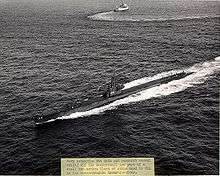USS Baya
USS Baya (SS/AGSS-318), a Balao-class submarine, was a ship of the United States Navy named for the baya.
_in_1962.jpeg) USS Baya (AGSS-318), post-conversion in 1962. | |
| History | |
|---|---|
| Builder: | Electric Boat Company, Groton, Connecticut[1] |
| Laid down: | 8 April 1943[1] |
| Launched: | 2 January 1944[1] |
| Commissioned: | 20 May 1944[1] |
| Decommissioned: | 14 May 1946[1] |
| Recommissioned: | 10 February 1948[1] |
| Decommissioned: | 30 October 1972[1] |
| Stricken: | 30 October 1972[1] |
| Fate: | Sold for scrap, 12 October 1973[1] |
| General characteristics | |
| Class and type: | Balao class diesel-electric submarine[2] |
| Displacement: | |
| Length: | 311 ft 9 in (95.02 m)[2] |
| Beam: | 27 ft 3 in (8.31 m)[2] |
| Draft: | 16 ft 10 in (5.13 m) maximum[2] |
| Propulsion: |
|
| Speed: | |
| Range: | 11,000 nautical miles (20,000 km) surfaced at 10 knots (19 km/h)[6] |
| Endurance: |
|
| Test depth: | 400 ft (120 m)[6] |
| Complement: | 10 officers, 70–71 enlisted[6] |
| Armament: |
|
Baya was launched on 2 January 1944 by Electric Boat Co., Groton, Conn.; sponsored by Mrs. Charles C. Kirkpatrick, and commissioned on 20 May 1944, Commander A. H. Holtz in command.
World War II
Baya arrived at Pearl Harbor in August 1944. During 23 August 1944 – 25 July 1945 she completed five war patrols in the South China Sea, Gulf of Siam, Java Sea, and Philippine Sea. Baya sank four Japanese vessels totaling 8855 tons and an 8407-ton passenger-cargo ship in conjunction with Hawkbill (SS-366).
Baya departed Subic Bay, Philippine Islands, in September 1945 and arrived at San Francisco on 24 September. Shortly thereafter she began inactivation and on 14 May 1946 went out of commission in reserve at Mare Island Naval Shipyard.
Baya received four battle stars for her World War II service.
Research submarine

Baya was recommissioned 10 February 1948 and converted to an electronics experimental submarine. Reclassified Auxiliary Research Submarine, AGSS-318, 12 August 1949, Baya conducted experiments for the Naval Electronics Laboratory San Diego, Calif., participated in local operations near San Diego and served with the joint American-Canadian Task Force gathering scientific data off western Canada in November and December 1948. During July–September 1949 she made a cruise to the Arctic to gather valuable scientific data in the Bering and Chukchi Seas. Between July and October 1955 she was deployed to Pearl Harbor on further experimental research.

Baya was used as a testbed for two early sonar transducer arrays which markedly changed her appearance. The first arrangement of 196 transducers in a 14×14 array was attached to the former gun mount abaft the conning tower, facing starboard and surrounded by a fairwater resembling a second conning tower.
After the first array and fairwater were removed, Baya was completely reworked at Mare Island Naval Shipyard during 1958 and 1959 to test the second array, called LORAD (for LOng RAnge Detection). The forward torpedo tubes were removed and replaced by a blunt bow containing the forward-facing transducer array. A mushroom anchor was installed in the bottom of the hull; and a 23-foot (7.0 m) section was added between the former forward torpedo room and the forward battery compartment, with quarters for twelve scientists. These modifications increased her overall length to 330 feet (100 m), and her submerged displacement to approximately 2,600 tons. Her maximum speed was reduced to 10.5 knots (19 km/h).[7]
Baya was decommissioned and struck from the Naval Register, 30 October 1972, and sold for scrapping, 12 October 1973.
References
- Friedman, Norman (1995). U.S. Submarines Through 1945: An Illustrated Design History. Annapolis, Maryland: United States Naval Institute. pp. 285–304. ISBN 1-55750-263-3.
- Bauer, K. Jack; Roberts, Stephen S. (1991). Register of Ships of the U.S. Navy, 1775-1990: Major Combatants. Westport, Connecticut: Greenwood Press. pp. 275–280. ISBN 0-313-26202-0.
- Bauer, K. Jack; Roberts, Stephen S. (1991). Register of Ships of the U.S. Navy, 1775–1990: Major Combatants. Westport, Connecticut: Greenwood Press. pp. 275–280. ISBN 978-0-313-26202-9.
- U.S. Submarines Through 1945 p. 261
- U.S. Submarines Through 1945 pp. 305–311
- U.S. Submarines Through 1945 pp. 305-311
- Friedman, Norman (1994). U.S. Submarines Since 1945: An Illustrated Design History. Annapolis, Maryland: United States Naval Institute. pp. 65–68. ISBN 1-55750-260-9.
- This article incorporates text from the public domain Dictionary of American Naval Fighting Ships. The entries can be found here and here.
External links
| Wikimedia Commons has media related to USS Baya (SS-318). |
- Photo gallery of Baya at NavSource Naval History
- USS Baya Homepage: USS Baya
- Kill record: USS Baya